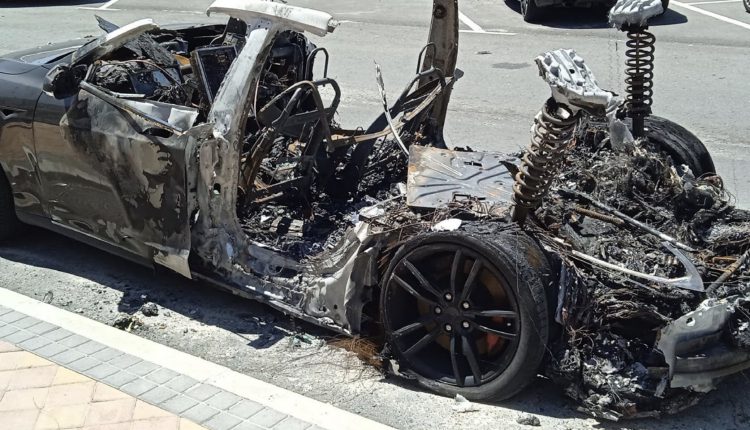Accidents and fires in electric cars
Accidentes e incendios en coches eléctricos
Dr. Pablo Zapico Gutiérrez (1); José Alonso de Linaje Aguirre (2); José Alejandro Alonso de Linaje Díez (3); María Zapico Gómez-Collantes (4); María García de Celis Rodríguez (5)
Resumen
La proliferación de vehículos eléctricos y sus incendios son un tema que preocupa a la sociedad actual. Los efectos del fuego, electricidad y el humo sobre las personas son un tema importante y de absoluta actualidad.
Palabras clave: Accidente, coche eléctrico, batería de litio, incendio, electrocución, intoxicación
Abstract
The proliferation of electric vehicles and their fires are an issue that worries today’s society. The effects of fire, electricity, and smoke on people are an important and current topic.
Keywords: Accident, electric car, lithium battery, fire, electrocution, poisoning
Recibido/received: 20/01/2025 Aceptado/accepted: 02/02/2025
(1) Department of Electrical Engineering, Systems, and Automation, University of León (Spain).
(2) Former Director of the Regional Fuel Laboratory, Government of Castilla y León.
(3) City Council of León.
(4) ENSIACET, Toulouse.
(5) Doctor INSS, León.
*Corresponding author: Dr. Pablo Zapico Gutiérrez; e-mail: pablo.zapico@unileon.es

The popularity of electric cars has grown exponentially in recent years, driven by the search for sustainable alternatives to conventional transportation. However, this increase has raised concerns about safety, particularly regarding fires in electric vehicles. Although these incidents are relatively rare compared to internal combustion cars, media coverage tends to be significant, creating alarm among consumers.
It is worth questioning whether social alarm exists and the media merely reflect it, or if the press itself is generating it; perhaps both possibilities are true. What is clear is that consumer goods which can unexpectedly catch fire in a virulent manner generate concern among citizens.
Let us examine some data on car fires. Since Spain has a very small fleet of electric vehicles and it is, therefore, not representative, it is necessary to look at countries with a higher percentage of these automobiles, such as Norway and Sweden.
Spain has 47.42 million inhabitants and 35.67 million vehicles, of which 0.184 million are electric (0.516%). That means one car per 1.33 inhabitants.
Sweden has 10.49 million inhabitants, with 58 % of cars being electric and/or hybrid. That equates to one car per 1.85 inhabitants. The statistics are much more representative than those in Spain.
In reality, during 2022 in Sweden (Fig. 1), only 24 fires were recorded in electric cars, and in Norway, 54 (Fig. 2); this represents just 0.004 % of the national fleet of electric and hybrid cars, compared to 0.08 % of combustion cars that caught fire in the same period. Thus, the number of electric cars incidents is lower.
Norway has 5.2 million inhabitants, with 85 % of vehicles being electric and/or hybrid. That equates to one car per 1.79 inhabitants.
Based on these data, it is clear the risk of fire in combustion cars is significantly higher than in electric cars. It is worth noting that the electric car fleet is newer than conventional automobiles, which may somewhat distort these data. Nonetheless, the reasons for some spontaneous fires in electric cars remain a mystery. Conventional vehicles typically catch fire in accidents. It is exceedingly rare for them to spontaneously combust while stationary in a parking lot. Electric cars, however, do.
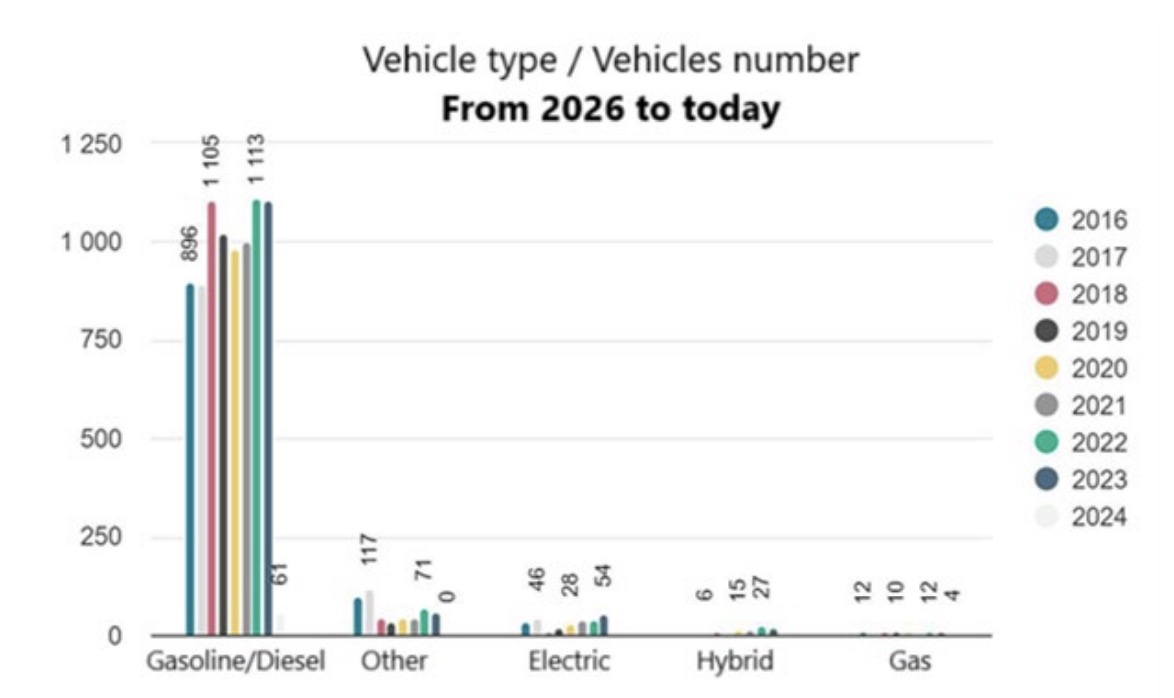
When an electric vehicle burns, whether a scooter, a passenger car, or an urban bus, media coverage is always greater, making it seem as though fires in electric cars are more common and more dangerous. They burn while parked or charging, which increases public perception of their danger. We will have to wait until the electric car fleet grows to determine definitively whether they are more prone to catching fire, but the reality is that there is a danger associated with electric cars, particularly regarding the severity of their fires. Although they are not very frequent, they can easily affect other nearby vehicles and/or any adjacent combustible materials, and they receive significant media attention, contributing to their negative public image.
Following the fires on the maritime transport ships Felicity Ace and Fremantle Highway, numerous shipping companies have implemented special protocols to transport electric vehicles. They must always travel with discharged batteries and must never be plugged in while on board. The problem is that when one of these vehicles catches fire, the flames can easily spread to others nearby. These fires are extremely virulent and affect adjacent vehicles, whether electric or not (Fig. 3). Shipping companies have been transporting gasoline and diesel vehicles for many years without ever having a car catch fire for no apparent reason, as has happened with electric cars.
Episodes like the one in Madrid, where a hybrid car caught fire on the third floor of the Castellana 200 shopping centre, forcing the building to be evacuated, are difficult to explain. Normally, a combustion car catches fire on the street and when in motion—not while stationary in a garage—making fires involving electric or hybrid vehicles much more dangerous and socially alarming. In September 2024, a fire caused by a charging mobile phone in a home in Guillena, Seville, resulted in four fatalities. This was caused by just a mobile phone battery, which is much smaller than that of an electric car or scooter.
Madrid’s metro system is another place where restrictions on batteries have been implemented: electric scooters have been banned because, in the event of a fire, they require an enormous amount of air to dilute combustion gases and volatile organic compounds (VOCs) to safe levels for users, who are in tunnels with limited ventilation. The Spanish national railway network (RENFE) has adopted the same measure. Additionally, the fire can reignite spontaneously within 24 hours of the initial fire.

Several countries, including China (the world’s largest manufacturer of electric vehicles), are banning electric cars from underground parking lots, prohibiting their charging in these garages, or restricting access when their battery charge exceeds 80-90 %. 2
The main dangers of lithium batteries are:
•Electrical overload (during charging and discharging).
•Overheating (thermal overload caused by external heat sources, energy input, or excessive use).
•Impacts (mechanical damage that releases the battery’s high energy density).
In certain situations, battery charging may be overstimulated, likely due to a charger malfunction that fails to regulate energy input, generating excessive heat and ultimately igniting the battery itself. This is why charging is carried out through a device that must regulate the battery’s power supply at all times —both voltage and current. One of the issues that arise is that these vehicles are often connected to the first available charger, regardless of whether that charger is suitable for the battery’s specific charging curve (Fig. 4). Ambient temperature plays a crucial role in the charging and discharging process —higher temperatures increase the risk of fire, posing a greater threat in Southern European countries, which experience higher environmental temperatures due to their geographic location.
An additional problem arises with chargers, especially fast chargers, as manufacturers, for the sake of reducing charging time, accept recharge currents that are multiples of the nominal operating current. This can dangerously raise the temperature of battery elements to the maximum permissible temperature (around 80 °C in some battery types). It has also been demonstrated that battery life is shortened. The final fifth of the charge, from 80 % to 100 % of total capacity, is particularly problematic, as the battery cells become more unstable in this phase.
When such situations occur, severe consequences may result:
•The battery can catch fire or even explode.
•Chemical reactions among its components (anode and cathode half-cells, electrolytes, casing, etc.) can release toxic gases that may be lethal.
•Lithium-ion battery fires are difficult to control and spread quickly.
•Firefighters are often limited to preventing the fire from spreading to adjacent areas. The greatest risk arises when these fires occur in enclosed or poorly ventilated spaces.

In private garages and most community garages, fire detection systems do not exist. Therefore, they should be integrated into chargers as an additional safety measure since chargers are closest to the electric vehicle and can provide an early fire alert.
Once a fire starts, the chemicals in the battery sustain it. Exothermic chemical reactions and internal explosions generate extremely high temperatures. The real issue, unlike combustion cars, is that once the battery starts burning, it is almost impossible to extinguish. The battery enters a thermal runaway process, which is very difficult to stop, and continues to burn even without atmospheric oxygen.
Some manufacturers compartmentalize the battery; others fill the spaces between cells with fire-retardant gel, and some are even designing special nozzles for injecting liquid nitrogen into the battery compartment. However, the issue remains that liquid nitrogen is not readily available at fire scenes, nor is it typically used by firefighters. One company has announced a “fireman access” in the battery for firefighters to flood it with a powerful jet, but accessing this fireman access becomes challenging if the fire has already progressed. ABC powder and CO2 extinguishers are largely ineffective, with the F500 extinguishing agent being slightly more effective, albeit four times more expensive.
To begin firefighting efforts, the burning must first be halted, and then the battery should be monitored for 24 to 48 hours to ensure it does not reignite. Firefighters report that extinguishing an electric vehicle’s traction battery requires between 25,000 and 90,000 litres of water, compared to 5,000 litres for a conventional vehicle.
Thermal blankets are also used to smother the flames, but while they can control combustion reactions, they do not stop uncontrolled internal chemical reactions. These blankets cost around €6,000 per unit, limiting their widespread use. Additionally, the internal reactions can generate their own oxygen, making the fire even harder to control. Since lithium battery electrolytes contain oxygen, they decompose and intensify the fire even without external air input (Fig. 5). Furthermore, lithium reacts strongly with water, producing hydrogen, which, combined with atmospheric oxygen and heat, tends to ignite and even detonate.
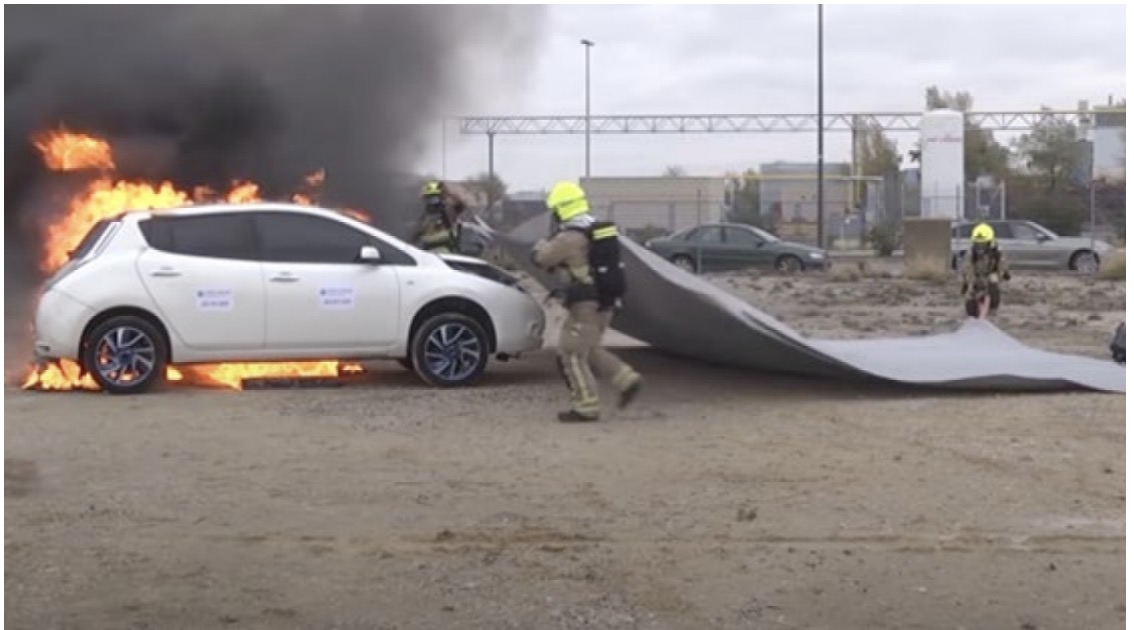
As previously mentioned, fires in electric vehicles are less frequent than those in conventional fuelpowered cars. However, they spread more easily to nearby combustible materials and are more difficult to extinguish under certain conditions.
The battery is likely the most solidly protected component of the vehicle, but in an accident, anything can happen. Localized forces can act unpredictably, and no two accidents are alike. While theoretically protected, real-world incidents show that this is not always the case.
In an accident involving another vehicle or an obstacle, mechanical forces can compromise the car’s structure or internal components, including the traction battery, which operates at voltages between 400 and 800 volts DC, depending on the manufacturer. Such voltage levels are high enough to cause severe harm or even death to a human body.
Living organisms conduct electricity. Electrification occurs when there is a potential difference between two points in the body. Tissues affected by an electrical current experience motor functional excitation, which can cause temporary or permanent injury.
The severity of injury depends on the energy released or the amount of electricity passing through the tissue. Generally, tissues with higher resistance to electrical current sustain more damage than more conductive ones. In humans, electricity enters through the skin and flows through various organs before exiting at a lower potential point.
The maximum tolerable contact voltage over time without causing electropathological effects is called the conventional voltage limit or safety voltage.

Electricity can affect any organ or tissue. If electrical energy passes through the heart, it may trigger involuntary muscle contractions and/ or stimulate cardiac electrical tissue, leading to various arrhythmias: sinus tachycardia, extrasystoles, flutter, atrial fibrillation (most common), or ventricular fibrillation (most severe). These disruptions can prevent the heart from functioning normally, reducing blood circulation, causing hypotension, oxygen deprivation, and potentially resulting in death within minutes (Fig. 6).
The likelihood of experiencing an arrhythmia depends on the intensity of the current, the transition time, and, most importantly, whether the electrical signal reaches the myocardium during the most vulnerable phase of the cardiac cycle: the beginning of the T wave on the electrocardiogram, corresponding to ventricular repolarization (Fig. 7).
Similarly, electric current can pass through the central or peripheral nervous system, causing different symptoms such as seizures, coma, cerebral anoxia, or paralysis of the respiratory muscles, depending on the affected area.
Electric energy also causes tissue damage through heating, meaning that electrical energy transforms into heat (Joule effect).
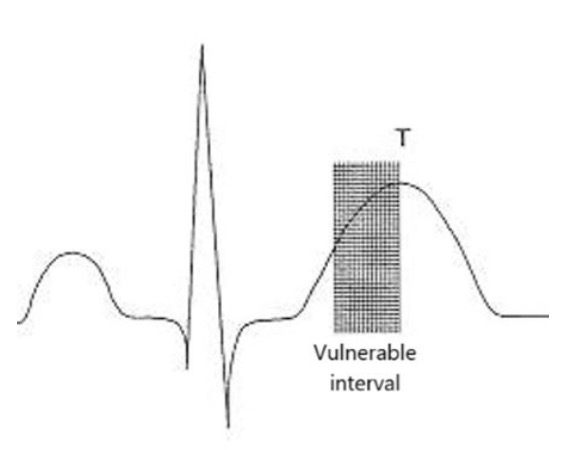
When in contact with the skin and mucous membranes, it can cause first, second, or third-degree burns depending on depth, extent, and body region. Deep and extensive burns lead to rapid intravascular fluid loss into the interstitial space, contributing to hypovolemia, hypotension, and ultimately hypovolemic shock. Figure 8 illustrates these effects on the skin and mucous membranes, depending on circulating intensity and application time. When in contact with internal organs, thermal energy causes massive edema, which, at the muscular level, can lead to compartment syndrome and/or rhabdomyolysis with the release of myoglobin that must be eliminated through urine, precipitating in the renal tubules, resulting in anuria.
In addition to the electrical and thermal effects of electric current, when a lithium battery combusts, a cloud of toxic, flammable, asphyxiating, and corrosive gases is released into the atmosphere. Due to the high temperature at which they are generated, these gases cause irritation and burns to any part of the body: skin, nasal mucosa, oropharyngeal, eyeball, genitals… Inhalation of these gases causes respiratory tissue injury with bronchial smooth muscle spasm, edema, and pneumonitis of the lung parenchyma, resulting in alterations in arterial-pulmonary gas exchange, with general symptoms such as headache, dyspnoea, nausea… and in severe cases, respiratory failure, seizures, decreased level of consciousness, coma, and so on.
Given the danger that exists, the possible measures to protect the occupants of an accident vehicle are going to be analyse:
•The first measure, whenever possible, is not to touch any metallic mass; unfortunately, this is not always possible.
• Secondly, it is important to know that the colour of the battery cables from the inverter to the motor is orange. These wires are the most dangerous ones. If any of them are cut, peeled, damaged, or loose, extra precautions should be taken.
• Thirdly, and if strictly necessary, insulating gloves should be used. In case of need, dry gloves in good condition can suffice, even if they are not ideal. If the environment is wet and/or raining (water is conductive due to the dissolved ions it carries), the danger is enormous and unacceptable for an untrained person, according to the authors.
• The priority in these types of electrical accidents is to break the contact between the victim and the power source. To do this, the electric energy must be diverted to “ground” before proceeding with evacuation and assistance from emergency medical services.
• Emergency services should carry equipment that diverts energy to the ground and extinguishes the fire with special chemicals for chemical and metal fires.
• Medical assistance will then proceed on-site: Check pulse and breathing to perform cardiopulmonary resuscitation if absent initially, provide ventilatory support, maintain cardiovascular stability, and immobilize any fractures or dislocations if present, and urgently transport the victim.
• Emergency personnel are exposed to similar risks as the affected individuals and, therefore, they must use electrical protection equipment called DISIPATIVE, which should constitute the outermost layer of the worker’s clothing and be connected to the ground through the worker’s body or via a direct ground connection. To protect workers from the thermal effects of a potential explosion, electrostatic protective clothing should include heat and flame protection. Gloves will protect against chemical, mechanical, heat, or flame hazards. Safety footwear will minimize the buildup of charge.
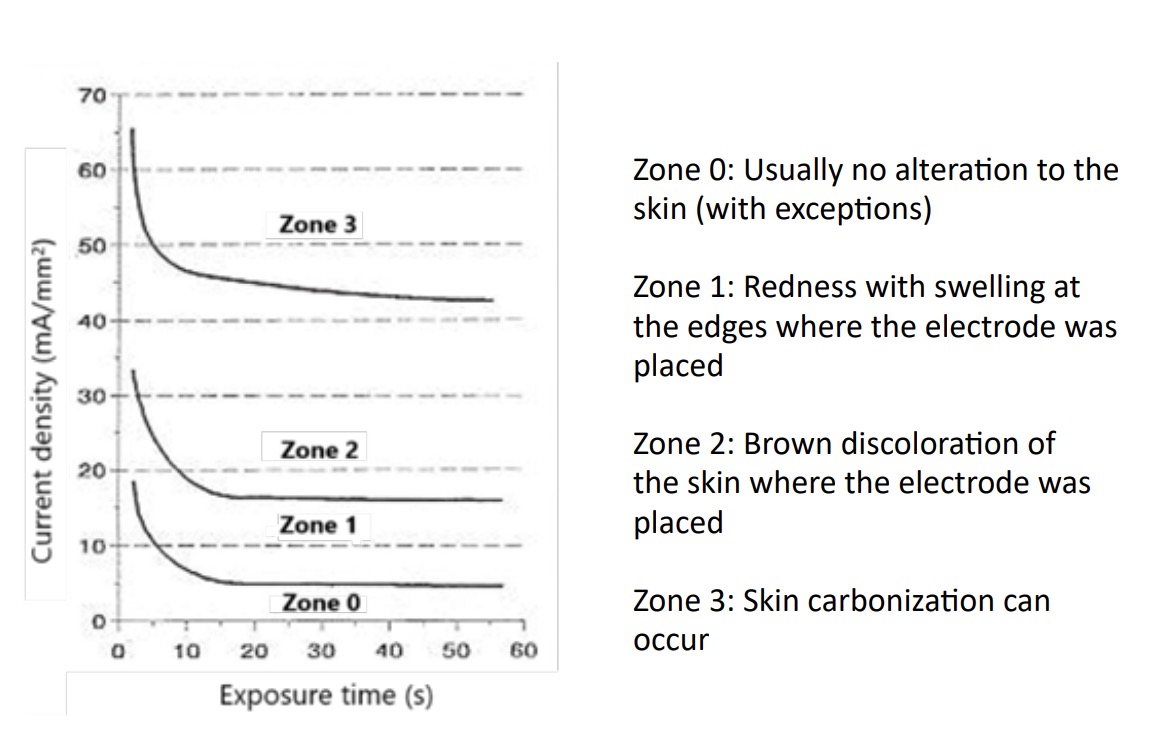
Recently, ISO 17840 standard has been published; this rule, which is not mandatory but indicative of national and international standardization, is pioneering in nature, laying the foundation and clarifying concepts. To begin with, it categorizes different types of vehicles by colour. Electric and hybrid vehicles are assigned the colour orange.
The term “high voltage,” referring to the electrical voltage of the traction battery, which does not align with national and international electrical standards, now seems like a lost cause. It was decided to be called it that, and it will be very difficult to modify the terminology, even if it is incorrect. It is important not to forget that the Spanish Electrotechnical Regulation for low voltage classifies voltages in its article 4 and considers low voltage to be up to 1,000 V in alternating current and 1,500 V in direct current. European regulations on this classification are very similar. These voltages are not yet exceeded by existing electric and/or hybrid cars on the market. Having certain contradictions between different regulations or official bodies in these definitions or classifications will cause problems in the more or less distant future. One must wonder how the judicial system will issue uniform rulings if technicians have previously classified things with contradictions.
In figure 9, the identifying colours for different technologies can be seen, and in figure 10, the proposed sign models by the ISO committee, which drafted the standard, are displayed. So far, it has not been implemented, and some manufacturers are not complying with it.
In the case of an active fire outdoors, the area should be cordoned off, and people should always be positioned upwind, in the opposite direction to the smoke plume from the fire. It should be avoided that people present are near the smoke plume. The outdoor situation will cause the rapid dilution of toxic gases.
Although unlikely, when an accident/fire occurs in a garage, tunnel, or enclosed space, the situation becomes very serious. If electrolyte from the batteries spills, its vapours are toxic, potentially flammable, and can form an explosive mixture. If the traction battery catches fire, the combustion gases are extremely harmful to health, and since it occurs in an enclosed space, the airborne contaminant is almost impossible to avoid. The response should be to evacuate as soon as possible. The best solution, even though it may intensify the fire, is to ventilate and always stay facing the incoming ventilation flow to avoid inhaling the combustion fumes and/or the chemicals generated. If the tunnel has evacuation galleries alternative to the main tube, it is better, as they provide a separate fire compartment with a different ventilation system. When the fire department arrives, they will have self-contained breathing apparatus, but even then, the heat generated by combustion can be a problem, even for them, despite their special protective equipment. Directive EU2024/1275, in its article 14.10, states that by December 31, 2025, the Commission will publish guidelines on fire safety in car parking facilities. This indicates that they are aware of the problem, but they are prioritizing chargers first, with fire safety measures to be studied later.
How to act in the event of a fire in an electric car, or similar, inside a building, tunnel, or garage? The situation is much more dangerous. First of all, there is no unlimited amount of air to dilute the gases produced by the combustion of the battery; on the contrary, the ventilation, or lack thereof, will determine the degree of danger in the environment. Given that these are enclosed spaces, the risk will always be high.
•The first measure, always, is to evacuate all personnel present to a safe outdoor space.
•Ventilate, if possible.
•Wait for the arrival of the firefighters and inform them of the situation, the origin, and the location of the fire.
When a lithium battery burns, it releases a cloud of gases into the atmosphere; the most significant ones are listed in table 1.
There are not many studies on the compounds produced in the fire of a lithium battery. One of the most comprehensive studies was conducted in Sweden, simply by heating the battery in a controlled nitrogen atmosphere. Even then, many components, mainly organic in nature, were found in the gas phase obtained during the tests, but they did not conclude whether these concentrations reach dangerous levels. (They quantify at least 17 components.) They even indicate that three organofluorophosphorylated compounds, similar to those used in chemical warfare (such as sarin) as neurotoxic agents, were detected at very low concentrations, but still found. The compounds with the highest measured concentration correspond to the electrolytes (organic carbonates) present in the cells. In the case of an uncontrolled fire, conditions could be even worse.
The aim is to calculate, under certain conditions and assumptions, whether exposure to the gases from a lithium battery fire poses a real danger. This will depend on the degree of dilution of the smoke, (generally rapid outdoors) and potentially much more dangerous in indoor or closed spaces. The smoke from a lithium battery fire can be hazardous to health, depending on the exposure time, ventilation, and the size of the battery.
The situation varies depending on the location. For example, road tunnels have forced ventilation designed to evacuate smoke from fires, while garages, subways, and other enclosed spaces do not have as much forced ventilation. On the other hand, ventilation helps the spread of the fire.
Calculation conditions: With each breath, we inhale about half a litre of air, but our lung capacity is much greater: an adult’s lungs can hold about 5 litres of air, which can reach up to 6 litres in athletes.
The number of times we breathe depends on the intensity of the physical activity we are performing. We breathe about 15 times per minute, which means we inhale approximately 7.5 litres of air in that time. In the case of a fire, the users cannot be considered at rest; anxiety, nervousness, moving around in an unfamiliar environment, and even walking fast, running, or perhaps helping someone else, all lead to deeper breaths, increasing the potential inhalation of toxins.
Pulmonary ventilation is defined as the volume of air that moves between the lungs and the outside per unit of time, with the unit typically being the minute. This is determined by multiplying the tidal volume by the respiratory frequency. For a healthy adult individual weighing about 70 kg, with a respiratory rate between 12 and 15 cycles per minute and a tidal volume of 500 to 600 mL, the ventilation would be between 6 to 7 litres per minute. Although tidal volume could be measured during both inspiration and expiration, it is usually considered to be the volume of expired air. Strictly speaking, it should be the average of the volume inspired and expired.
Meaning of the abbreviations used:
•DL50: Dose that is lethal to 50% of the individuals; the lower the value, the higher the toxicity (expressed in mg of substance/kg of animal weight; the administration method (oral, intravenous, intramuscular…) and the mortality time frame (30d, 60d…) should be indicated).
•CL50: Concentration that is lethal to 50% of the individuals.
•TLV: Threshold limit value: the concentration limit in air to which a person can be exposed for 8 hours without suffering adverse effects.
•TWA: Time-weighted average.
•EU-OEL: Occupational exposure limit for the short term.
•MAK: Maximum concentration in the workplace, which is the maximum permissible concentration a substance can reach in the workplace air without causing longterm health effects for workers.
•DNEL: Derived no effect level (occupational).
•Seveso Directive: Directive 2012/18/EU on the control of risks related to serious accidents involving hazardous substances.
•CAS: Chemical Abstracts Service (unique identification number for a chemical product).

From the experiment conducted by the Swedish researchers Bergtrom, U.; Gustafsson, A.; Hagglund, L.; Lejon, C.; Sturk, D.; Tengel, T., who used a single LFP (lithium, iron, phosphorus primarily) or NMC (lithium, nickel, manganese, cobalt, among other metals) battery element, table 1 is derived. This table contains data for a single cell (LR6), while the battery of an electric vehicle weighs about 400 kg and it is composed of hundreds of individual cells. If we multiply the values of a single cell by the approximate number of cells making up the entire battery, we can extrapolate the original data to the size of a real battery (both for electric vehicles and electric scooters). Even if we double the times, since it is impossible for the entire battery to catch fire at once and even double them again to account for dilution that occurs in a closed space but filled with clean air, the values reflected in the table are frankly concerning. This is particularly true if the fire occurs in a poorly ventilated environment (tunnel, residence, garage, etc.).
The problem is that if one element of the battery pack becomes uncontrollable and catches fire, it will be nearly impossible to control the entire battery. It will affect the adjacent elements, and so on, until the entire pack is consumed, resulting in the release of the corresponding toxic gases. Therefore, both electric cars and electric scooters, which in many cases are charged inside residences, represent a real and objective danger to users.

The results of the extrapolations and calculations can be seen in the tables included below. Two tables have been prepared: one calculates the contaminants produced in the fire of an electric car battery (which is generally recharged outdoors or in garages), and the other one in the fire of an electric scooter, which is usually charged inside a residence.
Other authors mention that the composition of the smoke from electric car fires includes HCN, NOx, and HF, in addition to the compounds already mentioned. All of these have a high level of toxicity, even at very low concentrations.
The results speak for themselves regarding the danger to people from lithium battery fires. These incidents cannot only cause immediate physical harm, but also release a significant amount of toxic and hazardous gases, which pose a serious health risk. The ability of these batteries to enter an uncontrolled combustion state and the difficulty in extinguishing fires further increase the danger in enclosed environments such as garages, tunnels, or homes.
Attention should be focused on prevention and the implementation of safety measures to mitigate these risks.
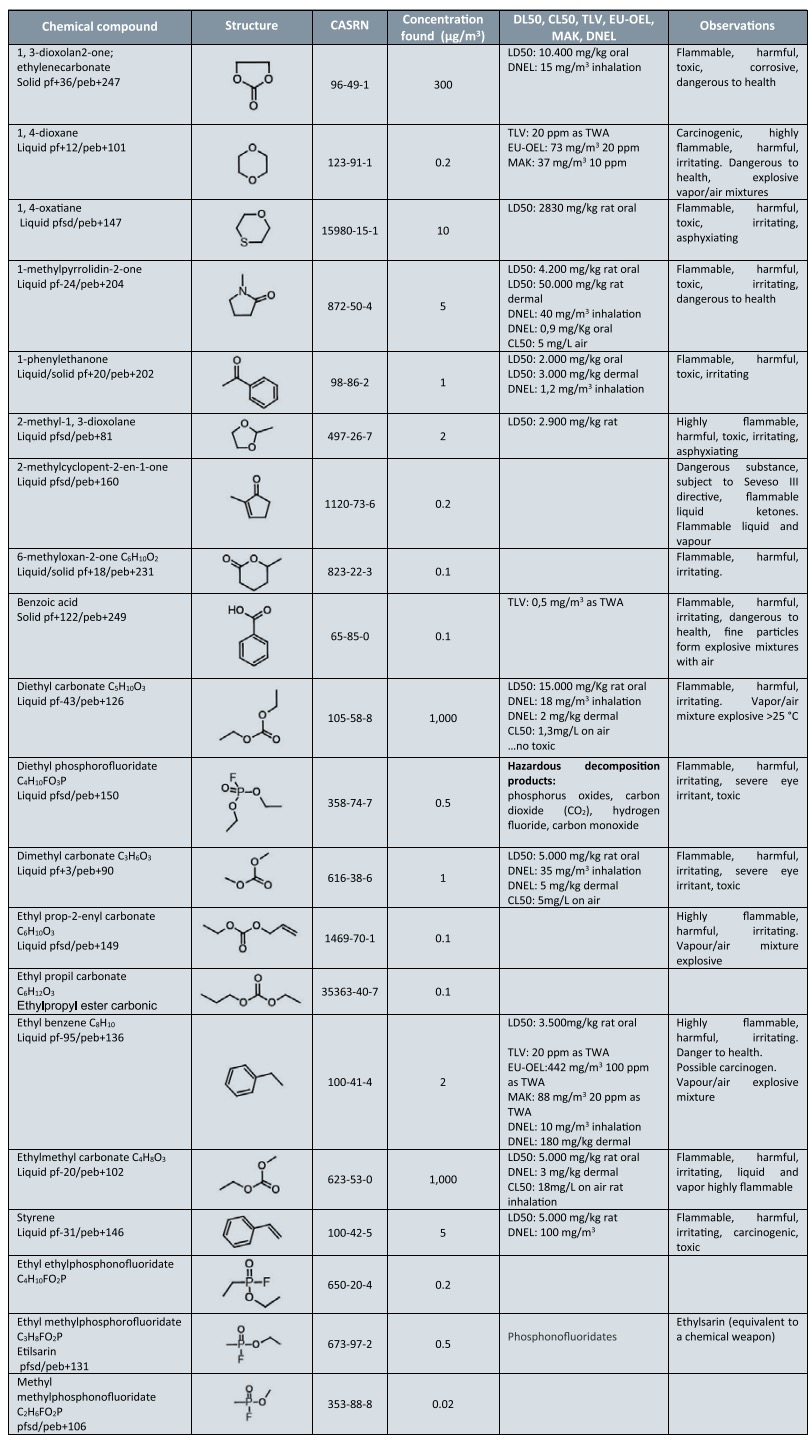

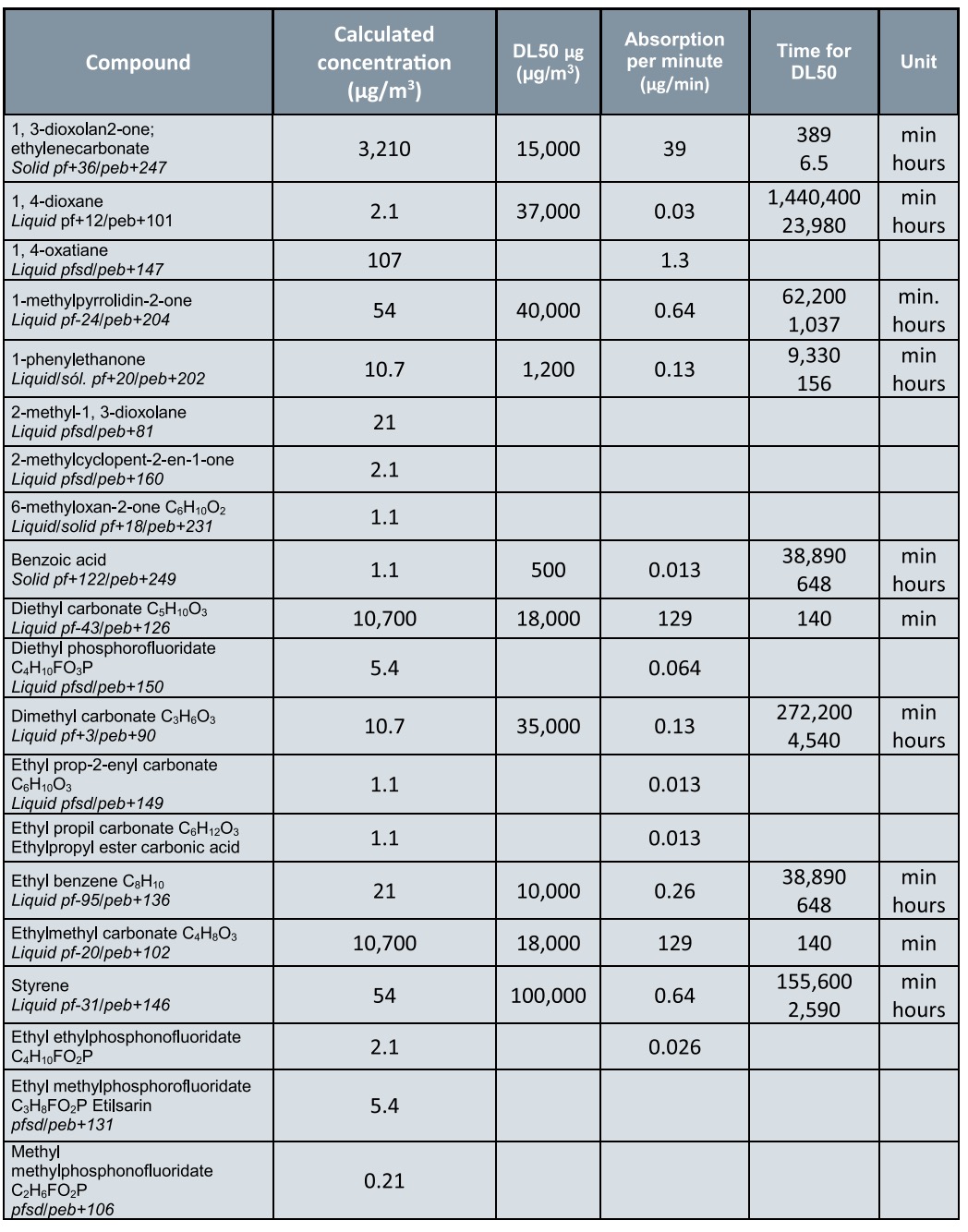
Acknowledgements
We would like to thank León Guardia Civil Traffic Subsector for their help and collaboration in the preparation of this article.
Bibliography
Álvarez Pelegry, E., & Menéndez Sánchez, J. (2017). Energías alternativas para el transporte de pasajeros.
Amsterdam Roundtable Foundation. (2014). Electric vehicles in Europe: gearing up for a new phase? Amsterdam.
Assum, T., Kolbenstvedt, M., & Figenbaum, E. (2014). The future of electromobility in Norway.
BASREC. (2015). The development of electric transport – its effect on the security of the electrical energy system and forecasting energy demand in chosen 8 BASREC countries (Norway, Denmark, Germany, Sweden, Finland, Estonia, Lithuania and Poland).
Bergtrom, U.; Gustafsson, A.; Hagglund, L.; Lejon, C.; Sturk, D.; Tengel, T. Vented gasses and an aerosol of automotive Li-Ion LFP and NMC batteries in humidified nitrogen under thermal load; Sweden 2015; https://www. msb.se/siteassets/dokument/publikationer/english-publications/ vented-gases-and-aerosol-of-automotive-li-ion-lfp-and-nmc-batteries-in-humidified-nitrogen-under-thermal-load.pdf
Bossche, V. D. (2008). Defining & Developing International Standards For Electric Vehicle Charging Infrastructures – What Are The Optimum Standards For Meeting Future Power & Charging Capabilities? American Business Conferences.
Caballero-Carvajal JA, Manrique-Hernández EF, Becerra-Ar C, et al. MSD manuales, Lesiones y envenenamientos, 1er Congreso Nacional de Seguridad y Salud en el Trabajo. Ministerio de Trabajo.
CEN/CLC/TR 16832:2015. Selection, use, care and maintenance of personal protective equipment for preventing electrostatic risks in hazardous areas (explosion risks). 60079-32-1:2013). UNEEN 60079-32-2:2016. Atmósferas explosivas – Parte 32-2. Riesgos electrostáticos. Ensayos. CEN/ CLC/TR 5404:2003. Electrostatics – Code of practice for the avoidance of hazards due to static electricity. INSHT, 2010. NTP887. Calzado y ropa de protección “antiestáticos”. UNE-EN IEC 61340-4-5:2018. Métodos de ensayo normalizados para aplicaciones específicas. Métodos para la caracterización de la protección electrostática del calzado y el suelo en combinación con una persona.
Chaouachi, A., Covrig, C. F., & Fulli, G. (2016). Framework for Electric Vehicles and Photovoltaic Synergies. JRC technical report .
Circutor. (2017). circutor.es. Obtenido de http://circutor.es/es/ productos/recargainteligente-para-vehiculos-electricos/ recarga-exterior-de-vehiculoselectricos/poste-recarga-exterior-2-tomas-rve2-pt3-detail
Cobb, J. (2017). Top 10 Plug-in vehicle adopting countries of 2016. Obtenido de http://www.hybridcars. com/top-10-plug-in-vehicle-adopting-countries-of-2016/
Comini, Renzo. Enciclopedia de salud y seguridad en el trabajo. Electricidad. INSST.ES
Comisión Nacional de los Mercados y la Competencia (15 de abril de 2015). Informe sobre la propuesta de planificación de la red de transporte de energía eléctrica 2015- 2020.
Folliot, Dominique. Efectos fisiológicos de la electricidad, 40.2 Prevención y normas.
Concheso Alvarez, A. Nuevos ánodos de carbon para baterías de ion-litio. Departamento de Ciencia de los materiales. Universidad de Oviedo.
COTEVOS. (2017). Business Opportunities for Interoperability Assessment of EV Integration.
Department of Energy, U. S. (2016). Developing Infrastructure to Charge Plug-In.
Electric Vehicles. Obtenido de https:// www.afdc.energy.gov/fuels/electricity_infrastructure.html
Dirección General de Tráfico, Anuario Estadístico General 2022, Madrid. Electromaps.com. (2017).
Electromaps. Obtenido de www.electromaps.com
DIRECTIVA (UE) 2024/1275 DEL PARLAMENTO EUROPEO Y DEL CONSEJO, de 24 de abril de 2024, relativa a la eficiencia energética de los edificios.
Elektromobilität, S. (2017). The Showcase Regions for Electric Mobility. Obtenido de http:// schaufensterelektromobilitaet.org/ en/content/ueber_das_programm/


